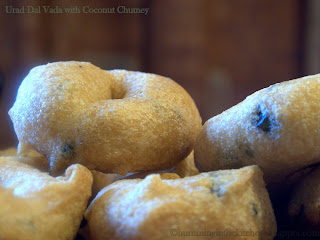 Uzhunnu Vada needs no introduction :) Made from Urad Dal, it is served with Sambar and or Chutney or both. Crispy and yummy, it is a favorite among kids and grown ups.
Uzhunnu Vada needs no introduction :) Made from Urad Dal, it is served with Sambar and or Chutney or both. Crispy and yummy, it is a favorite among kids and grown ups.Idli, Vada, Sambar & Chutney would undoubtedly rank very high in the top ten breakfast favorites if you ask any South Indian. Combined with Filter Coffee, (or Filter Kaapi) it can't get any better than that if you ask me. Definitely in my top five list :)
We had this crispy crunchy snack for our evening tea this weekend. Enjoyed it with friends - what could be better than that?
Ingredients for the Vada-
Whole or split Urad Dal (without the skin) - 2 cups
Thai Green Chillies - 10 or 12 chopped- adjust according to desired level of heat
Ginger - 1 inch piece, chopped very fine
Curry Leaves - 3 or 4 sprigs, chopped coarsely
Asafoetida (Hing) - 1/4 to 1/2 teaspoon
Peppercorns - optional - 2 tablespoons
Finely minced fresh coconut - optional - 2 tablespoons
Oil for frying
Salt - about 3/4 teaspoons - adjust according to taste
Yeilds about 25 - 30 medium sized vadas
Method -
Rinse urad dal in water a few times until the rinsing water runs clear. Soak rinsed urad dal in water for one and a half hours.
Drain the soaked dal, reserve the soaking water. Add salt and asafoetida to the soaked dal, grind to a smooth paste in batches. Add tablespoons of soaking liquid as required, to assist grinding. Make sure you don't add too much water, making the doughnut shape would be hard with a watery dough. This is the reason salt is added at the beginning, because adding salt at the end and mixing it up will release moisture which will then turn the dough watery.
In a medium sized bowl, add the ground dal, chopped green chillies, curry leaves, chopped ginger, peppercorns, minced coconut, and mix well to combine evenly. Take about 2 cups of water in a bowl, set it next to the ground dal mixture. Moistening the palms will release the vadas easily from your palm.
Heat oil in a pan. The oil should be sufficient enough to deep fry 5 or 6 vadas at one time. Drop a tiny ball of dough in the oil to make sure it is heated just right. If the tiny ball rises to the surface soon, it means that oil has heated just right.
Dip the fingers of the right hand in the water bowl. Pat your left palm with the wet right hand. Make a lemon sized ball of dough with the right hand and form a circular, flat patty on the left hand. Make a hole in the patty with the right index finger and gently release it onto your right hand. Slide the vada into hot oil. Depending on the pan and the amount of oil, you should be able to make about 5 or 6 vadas in a batch. Continue making vadas, each time with wet fingers.
I know this might sound silly but please make sure you don't accidentally dip your fingers in oil. (My classmate in college while making samosas, did this and showed up in the hostel with three blistered fingers. oh no!)
To serve crisp vadas for a party, here is a tip I learnt from my dad. When making large numbers, the vadas are fried in two batches. The first time, the vadas stay in hot oil for barely a minute or two, to hold their shape. The entire dough is made into vadas, fried quickly and removed from oil. This can be done ahead of time. Here are the vadas, fried quickly once - notice how they are still pale brownish white but holding their shape. These are clearly not cooked in the inside as you can tell.
 When the vadas are fried the second time, add 7 or 8 vadas in a batch instead of 5 or 6. Don't worry about overcrowding the pan because they won't stick to each other since they are already fried once. I do this everytime I make them. I have seen that double frying gives home made vadas the restaurant style crunch. Once they are golden brown in color, remove from oil. Serve hot with Coconut Chutney.
When the vadas are fried the second time, add 7 or 8 vadas in a batch instead of 5 or 6. Don't worry about overcrowding the pan because they won't stick to each other since they are already fried once. I do this everytime I make them. I have seen that double frying gives home made vadas the restaurant style crunch. Once they are golden brown in color, remove from oil. Serve hot with Coconut Chutney. Coconut Chutney Ingredients-
Coconut Chutney Ingredients-Grated coconut - 1 cup - fresh or frozen. If using frozen, thaw to room temparature.
Thai green chillies - 5 or 6 - according to your taste
Ginger - 1/2 inch piece
Pottukkadalai (Dalia) - 2 tablespoons
Cilantro - 5 or 6 stems with leaves - cleaned well and chopped
Salt - according to taste
Method -
Grind everything well in a blender or mixie jar with sufficient water and transfer to a serving bowl. Adding tadka to the chutney is optional.
 Enjoy with friends and loved ones :)
Enjoy with friends and loved ones :)






 There you have it, creamy and delectable mango pudding. We loved having this luscious pudding for dessert after our Sunday lunch. Made from the high calorie condensed milk and cream cheese, what's not to like? :)
There you have it, creamy and delectable mango pudding. We loved having this luscious pudding for dessert after our Sunday lunch. Made from the high calorie condensed milk and cream cheese, what's not to like? :)
